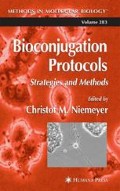Abstract
This method describes the conjugation of a synthetic glycopeptide to the N-terminus of a recombinant human interleukin-2 (IL-2) protein fragment. The IL-2 protein fragment is produced as an affinity-tagged fusion protein in Escherichia coli and then cleaved with the highly selective TEV protease to remove the affinity tag and uncover an N-terminal cysteine. The N-terminal cysteine is then used in native chemical ligation reaction to join the IL-2 protein fragment to a glycosylated tripeptide thioester that had been previously synthesized to produce a glycosylated form of IL-2.
Access this chapter
Tax calculation will be finalised at checkout
Purchases are for personal use only
References
Sears, P., Tolbert, T., and Wong, C.-H. (2001) Enzymatic approaches to glycoprotein synthesis. Genet. Engin. 23, 45–68.
Davis, B. G. (2002) Synthesis of glycoproteins. Chem. Rev. 102, 579–601.
Dawson, P. E. and Kent, S. B.H. (2000) Synthesis of native proteins by chemical ligation. Annu. Rev. Biochem. 69, 923–960.
Erlanson, D. A., Chytil, M., and Verdine, G. L. (1996) The leucine zipper domain controls the orientation of AP-1 in the NFAT.cntdot.AP-1.cntdot.DNA complex. Chem. Biol. 3, 981–991.
Marcaurelle, L. A., Mizoue, L. S., Wilken, J., Oldham, L., Kent, S. B., Handel, T. M., et al. (2001) Chemical synthesis of lymphotactin: a glycosylated chemokine with a C-terminal mucin-like domain. Chemistry 7, 1129–1132.
Xu, M.-Q., and Evans, T. C., Jr. (2001) Intein-mediated ligation and cyclization of expressed proteins. Methods 24, 257–277.
Kochendoerfer, G. G., Chen, S. Y., Mao, F., Cressman, S., Traviglia, S., Shao, H., et al. (2003) Design and chemical synthesis of a homogeneous polymer-modified erythropoiesis protein. Science 299, 884–887.
Tolbert, T. J. and Wong, C.-H. (2000) Intein-mediated synthesis of proteins containing carbohydrates and other molecular probes. J. Am. Chem. Soc. 122, 5421–5428.
Hofmann, R. M. and Muir, T. W. (2002) Recent advances in the application of expressed protein ligation to protein engineering. Curr. Opin. Biotechnol. 13, 297–303.
Tolbert, T. J. and Wong, C.-H. (2002) New methods for proteomic research: preparation of proteins with N-terminal cysteines for labeling and conjugation. Angew. Chem., Int. Ed. 41, 2171–2174.
Wang, A., Lu, S.-D., and Mark, D. F. (1984) Site-specific mutagenesis of the human interleukin-2 gene: structure-function analysis of the cysteine residues. Science 224, 1431–1433.
Mizuno, M., Haneda, K., and Iguchi, R. (1999) Synthesis of a glycopeptide containing oligosaccharides: chemoenzymic synthesis of eel calcitonin analogs having natural N-linked oligosaccharides. J. Am. Chem. Soc. 121, 284–290.
Zhang, L. and Tam, J. P. (1996) Thiazolidine formation as a general and site-specific conjugation method for synthetic peptides and proteins. Anal. Biochem. 233, 87–93.
Zhao, Z. G., Im, J. S., Lam, K. S., and Lake, D. F. (1999) Site-specific modification of a single-chain antibody using a novel glyoxylyl-based labeling reagent. Bioconjugate Chem. 10, 424–430.
Villain, M., Vizzavona, J., and Rose, K. (2001) Covalent capture: a new tool for the purification of synthetic and recombinant polypeptides. Chem. Biol. 8, 673–679.
Erlanson, D. A. and Verdine, G. L. (1997) Chemical ligation of EDTA to recombinant proteins: a new strategy for affinity cleavage. Protein Eng. 10, 47.
Shiraishi, H., Kataoka, M., Morita, Y., and Umemoto, J. (1993) Interactions of hydroxyl radicals with tris (hydroxymethyl) aminomethane and Good’s buffers containing hydroxymethyl or hydroxyethyl residues produce formaldehyde. Free Radical Res. Commun. 19, 315–321.
Lucast, L. J., Batey, R. T., and Doudna, J. A. (2001) Large-scale purification of a stable form of recombinant tobacco etch virus protease. BioTechniques 30, 544, 546, 548, 550, 554.
Author information
Authors and Affiliations
Editor information
Editors and Affiliations
Rights and permissions
Copyright information
© 2004 Humana Press Inc.
About this protocol
Cite this protocol
Tolbert, T.J., Wong, CH. (2004). Conjugation of Glycopeptide Thioesters to Expressed Protein Fragments. In: Niemeyer, C.M. (eds) Bioconjugation Protocols. Methods in Molecular Biology™, vol 283. Humana Press, Totowa, NJ. https://doi.org/10.1385/1-59259-813-7:255
Download citation
DOI: https://doi.org/10.1385/1-59259-813-7:255
Publisher Name: Humana Press, Totowa, NJ
Print ISBN: 978-1-58829-098-4
Online ISBN: 978-1-59259-813-7
eBook Packages: Springer Protocols

